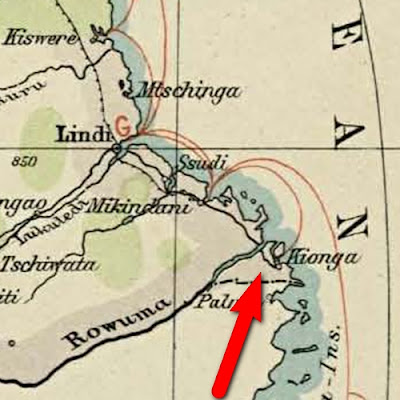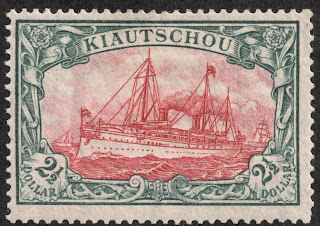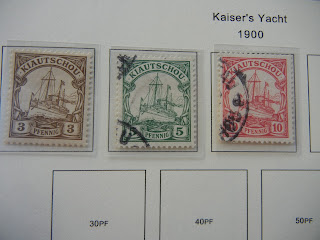1923-24 Scott 8 4a olive green
Overprinted, On stamps of India, 1911-23
Quick HistoryKuwait, on the shore of the Persian Gulf of the Arabian Peninsula, was a Sheikhdom under British Protectorate after WW I.
The Capital was Kuwait City, and the population was 50,000 in 1940.
Kuwait on the Arabian Peninsula
This small Arabic country, only 7,000 square miles, though, became the 5th richest per capita country in the world after large oil fields were discovered in 1937.
Kuwait is bordered by Saudi Arabia and Iraq.
Kuwait
Kuwait, meaning "fortress built near water", ended their British protectorate status in 1961, and became independent.
From 1923-1940, overprinted stamps of India were used, and the Kuwaiti postal service was administered through the Iraqi postal administration.
Then the Indian postal administration assumed control between 1941-47. During 1941-45, unoverprinted stamps of India were used. An overprinted 1945 issue was then produced using stamps of India.
Pakistan briefly (1947-48) administered control.
Great Britain assumed control on April 1, 1948, and the British postal administration issued overprinted British stamps from 1948-51- the end of our classical era coverage.
Of interest: Kuwaiti culture has contributed the "Dewaniya", a reception area where a Kuwaiti man will receive his male guests. There, topics are discussed, networking activities occur, and alliances are formed and strengthened.
1939 Scott 50 6a peacock blue "Mail Steamer"
Overprinted, On stamps of India, 1937
Into the Deep Blue
The 2011 Scott Classic specialized catalogue has, between 1923-1951, 199 major descriptions for regular, air post, and official categories. Of those, only 17 ( 9%) are CV $1+. Many are in the CV $3-$10+ range.
Kuwaiti stamps are a bit more expensive than many British protectorate stamps.
A closer look at the stamps and issues
16 Annas = 1 Rupee
16 Annas = 1 Rupee
1923-24 Scott 9 6a bister, wmk "Star"
Overprinted, On stamps of India, 1911-23
The first issue for Kuwait consisted of 15 stamps from the 1911-23 India "George V" issue that were overprinted. Six stamps have a CV of $3-$6+. These stamps have the watermark 39- "Star".
Then, between 1929-37, another similar issue of 14 stamps was overprinted, this time using the 1926-35 "George V" stamps of India with the watermark 196-"Multiple Stars". This issue has a CV of $1+-$4 for seven stamps.
Kuwait uses the "George V" India stamps with watermarks
"Star" (upper right), and "Multiple Star" (Lower example)
Forgot the watermarks? Here they are from the "India" post. ;-)
1939 Scott 48 3a yellow green "Dak Tonga"
Overprinted, On stamps of India 1937
In 1939, a 13 overprinted stamp set was produced using the 1937 "George VI" pictorial issue of India. CV for five stamps is $1+-$3+.
1945 Scott 64 2a scarlet
Overprinted, On stamps of India 1940-43
Recall that the Indian postal administration assumed control of the Kuwaiti postal service in May, 1941, and unoverprinted stamps of India were used.
But in 1945, an overprinted set of 13 stamps was issued, as illustrated. The CV is $1+-$5+ for 10 stamps.
1948-49 Scott 77 3a on 3p violet "King George VI"
Overprinted and Surcharged, On stamps of Great Britain.
The British postal administration assumed control in 1948, and stamps of Great Britain were subsequently overprinted and surcharged.
The 1948-49 set had 11 stamps, with a CV of $1+-$2+ for 7 stamps.
Deep Blue
Deep Blue (Steiner) has 10 pages for 1923-51 Kuwait, and follows the Scott catalogue exactly.
1945 Scott 60 1/2a rose violet
Overprinted, On stamps of India, 1940-43
Big Blue
Big Blue '69, on one page, has 20 regular spaces (1923-1939), and 4 Official stamp spaces (1923-33). Total = 24 spaces. The 2011 catalogue has 131 major numbers for the years up to 1939. Coverage, then, is 18%.
Observations....
• The '69 edition places "Kuwait" before "Korea". The '41/'43/'47 editions have "Kuwait" on the same page as the beginning of the "Leeward Islands". Consequently, the '41/'43/'47 editions only have 20 spaces for Kuwait, and leave out the 1939 53,54,(55),(56) spaces.
• The '69 ( and '97) edition have a least expensive blank spaces choice of Scott 56 10r rose carmine & dark violet @ $85. ! Five more stamps are CV $10+-$20.
• As one would expect, the India George V overprinted issues with two different watermarks and catalogue numbers are only given one space in Big Blue. In addition, the 1934 1/2c green (Scott 18) and 4a olive green (Scott 27), which differ in design, can also be put into the spaces.
Checklist
1923-37*
1 or 17 or 18, 2 or 19, 3, 4 or 21,
22 or 23, 5,25,6,8 or 26 or 27, 9 or 28,
1939
45,46,
49,50,51,(48),
53,54,(55),(56),
Official Stamps
1923-33
O1,O2*,(O3),(O4),
Comments
A) Expensive stamps ($10 threshold):
1934 Scott 27 4a olive green ($10)
1923-24 Scott 9 6a bister (10+)
1939 Scott 51 8a blue violet ($10+)
1939 Scott 54 2r dark brown & dark violet ($10+)
1939 (Scott 55) 5r deep ultramarine & dark green ($20)
1939 (Scott 56) 10r rose carmine & dark violet ($85) !
B) As usual for BB, two watermarked sets are combined and given one space. Also the 1934 1/2c green (Scott 18) and 4a olive green (Scott 27), which differ in design, can also be put into the spaces.
C) ( ) around a space indicates a blank space choice.
D) *O2 1a "brown"- not the O15 1a "dark brown", because of color specification.
1948-49 Scott 73 1a on 1p vermilion
Overprinted and Surcharged, On stamps of Great Britain
Out of the Blue
Of interest, Kuwait's oil boom only really occurred after independence in 1961. I suspect the British might have provided a little more postal attention otherwise.
Have a comment?





















































